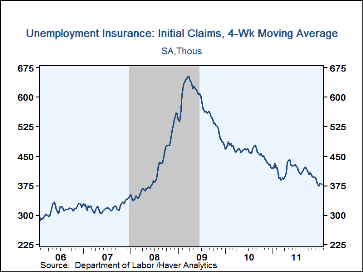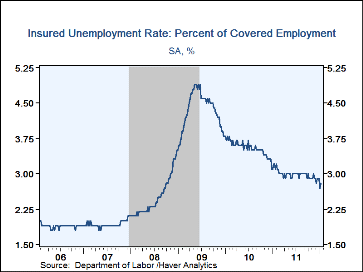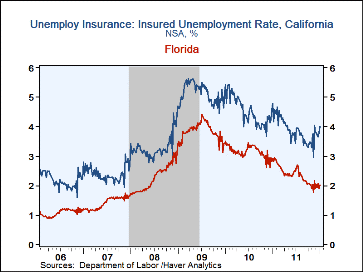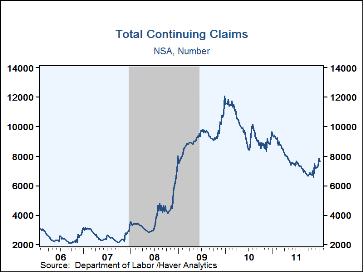 Global| Jan 26 2012
Global| Jan 26 2012U.S. Initial Claims For Jobless Insurance Move Slightly Higher
by:Tom Moeller
|in:Economy in Brief
Summary
First-time claims for jobless insurance rose last week but the recent trend lower remained intact. Initial claims for unemployment insurance rose to 377,000 last week from 356,000 during the previous period (revised from 352,000). [...]
First-time claims for jobless insurance rose last week but the recent trend lower remained intact. Initial claims for unemployment insurance rose to 377,000 last week from 356,000 during the previous period (revised from 352,000). Claims averaged 430,000 during January, one year ago. Expectations had been for 370,000 claims in the Action Economics survey. The 4-week moving average slipped to 377,500.
Continuing claims for unemployment insurance rose 88,000 to 3.554M during the week of January 14. That followed a 181,000 decline the prior week. The insured unemployment rate ticked up to 2.8% but remained near the recovery low. This particular count covers only "regular" programs and does not include all extended benefit and other specialized jobless insurance programs. In the January 7th week, the latest figure available, the grand total of all benefit recipients fell to 7.638 mil. (-18.8% y/y).
By state, the insured unemployment rate varied as of January 7 with Virginia (1.8%), Texas (1.9%), Florida (2.0%), Arizona (2.4%), Tennessee (2.6%), Ohio (2.8%) and Indiana (2.9%) at the low end of the range. At the high end were rates in North Carolina (3.5%), New York (3.6%), California (4.0%), Connecticut (4.2%), New Jersey (4.3%), Michigan (4.6%) and Pennsylvania (4.8%).
Data on weekly unemployment insurance programs are contained in Haver's WEEKLY database, including the seasonal factor series, and they are summarized monthly in USECON. Data for individual states, including the unemployment rates that determine individual state eligibility for the extended benefits programs and specific "tiers" of the emergency program, are in REGIONW, a database of weekly data for states and various regional divisions. Action Economics consensus estimates are in AS1REPNA.
| Unemployment Insurance(000s) | 01/21/12 | 01/14/12 | 01/07/12 | Y/Y% | 2011 | 2010 | 2009 |
|---|---|---|---|---|---|---|---|
| Initial Claims | 377 | 356 | 402 | -14.9 | 409 | 459 | 574 |
| Continuing Claims | -- | 3,554 | 3,466 | -11.6 | 3,745 | 4,544 | 5,807 |
| Insured Unemployment Rate (%) | -- | 2.8 | 2.7 | 3.2 (1/11) |
3.0 | 3.6 | 4.4 |
| Total "All Programs" (NSA) | -- | -- | 7.638M | -18.8 | 2.750M | 9.850M | 9.163M |
Tom Moeller
AuthorMore in Author Profile »Prior to joining Haver Analytics in 2000, Mr. Moeller worked as the Economist at Chancellor Capital Management from 1985 to 1999. There, he developed comprehensive economic forecasts and interpreted economic data for equity and fixed income portfolio managers. Also at Chancellor, Mr. Moeller worked as an equity analyst and was responsible for researching and rating companies in the economically sensitive automobile and housing industries for investment in Chancellor’s equity portfolio. Prior to joining Chancellor, Mr. Moeller was an Economist at Citibank from 1979 to 1984. He also analyzed pricing behavior in the metals industry for the Council on Wage and Price Stability in Washington, D.C. In 1999, Mr. Moeller received the award for most accurate forecast from the Forecasters' Club of New York. From 1990 to 1992 he was President of the New York Association for Business Economists. Mr. Moeller earned an M.B.A. in Finance from Fordham University, where he graduated in 1987. He holds a Bachelor of Arts in Economics from George Washington University.










